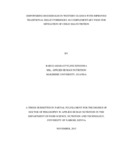Empowering households in western Uganda with improved traditional millet porridges as complementary food for mitigation of child malnutrition

View/
Date
2015-11Author
Barugahara, Evyline I
Type
ThesisLanguage
enMetadata
Show full item recordAbstract
Child malnutrition is a problem in Western Uganda where finger millet porridge is a common complementary food. The aim of this thesis was to empower households in Western Uganda with improved millet porridges as a mitigation strategy for child malnutrition. The study involved analysis of the factors responsible for the poor nutritional status among children in Bujenje County of Western Uganda, formulation of improved millet porridges and their evaluation in both hospital and community settings. Data on child nutritional status and its contributory factors was collected using anthropometric measurements and questionnaires respectively. Proximate analysis of composite flours was done according to Association of Official Analytical Chemists (AOAC) methods while agar diffusion technique and a seven point hedonic scale were used to analyse the antimicrobial and sensory attributes of the developed porridges respectively. Porridge flours were formulated using finger millet (Eleusine coracana), pumpkin flesh (Curcurbita maxima) and Moringa oleifera leaf powders with the target of providing not less than 60% Recommended Nutrient Intake for protein, vitamin A, iron and zinc. They were fermented using lactic acid fermentation starter cultures. Evaluation of the rehabilitative effect of moringa and pumpkin millet porridges among children with severe acute malnutrition (SAM) in Mulago hospital against the control of F-100 milk; and among moderately malnourished children in Bujenje County against the control of traditional millet porridge, was carried out. Data was processed using SPSS version 20.0 for windows; and descriptive and inferential statistics computed at p< 0.05 level of significance. The factors contributing to the poor nutritional status of children in Bujenje County were diarrhoea; lower levels of maternal education, millet porridges, health care practices and household income. Nutritional value and perfomance of traditional millet porridges were significantly improved by incorporation of 7% moringa leaves and 17% pumpkin flesh together with lactic fermentation, without compromising on acceptance. The improved millet porridges also had antimicrobial activities against common selected diarrhea pathogens. The rehabilitative value for the improved millet porridges was found to be 92-97% compared to F-100 milk (thehospital rehabilitation ration). At the community level, children fed on moringa and pumpkin millet porridges had a quicker recovery rate from wasting and underweight and significantly reduced incidences of diarrhoea compared to children fed on the traditional millet porridge. The technologies involved in the production of improved millet porridges can therefore be adopted by mothers to mitigate child malnutrition in Western Uganda.
Publisher
University of Nairobi
